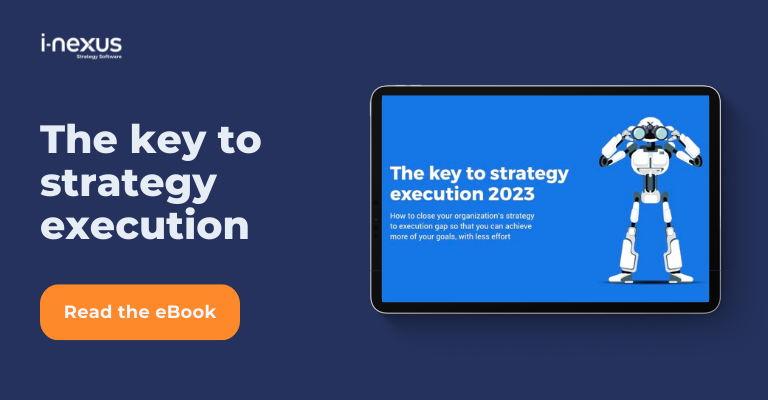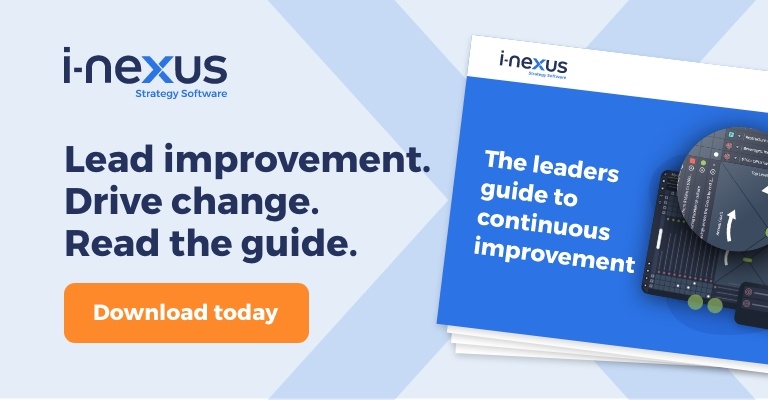Peter Drucker once said that “culture eats strategy for breakfast”. So, how can PMOs and Transformation teams stimulate an appetite for transformation and help people develop a taste for strategic change?
Written by: James Milsom, Head of Marketing
As the 2020s continue to prove, we live in an era of rapid, profound, and unpredictable change.
Societal shifts, economic crises, and ecological change impact business models across every industry. The winners will be the organizations that can adapt fastest and most effectively to changing conditions.
That’s why the role of strategy in the organization is more critical now than ever. PMOs and Transformation teams take note.
Historically, Peter Drucker’s dictum that “culture eats strategy for breakfast” has generally been true for most organizations.
The existing organizational culture has always predominated over the desire for strategic change.
And, according to a major recent Gartner survey of C-level executives, culture remains a key blocker to Strategy Execution:
"46% of respondents named culture as the biggest barrier to scaling digital transformation."
Gartner, Here’s Why CIOs Will Be the New Executive Leaders
This blog addresses the role that PMOs and Transformation teams can play in helping their organization to improve their strategic collaboration through what is known as culture hacking and seven ideas to try hacking for yourself.
Culture hacking and strategy execution
You would be forgiven for imagining a computer hacker when we say 'culture hacking'.
What is culture hacking?
So, what exactly is culture hacking?
Tech Target defines culture hacking as being one tool in change management, stating:
"Culture hacking applies small iterative changes that can have larger than expected results in the overall culture and work environment, increasing employee engagement and promoting a healthy work-life balance...
[Unlike best practices] culture hacking attempts to take a more organic approach to adapt to the organization and it’s people.Culture hacks can be suggested by management, though suggestions often come from employees.
Culture hacking generally seeks an emotional response, which is suggested as an effective way to change behavior."
Defining culture hacking within the world of strategy execution
In strategy execution, culture hacking can be used to combat and dismantle the “that’s not how we do things here” mentality that stands in the way of so many business transformation programs.
The results can be hugely beneficial for strategy teams, including:
- Creating tighter feedback loops on strategic initiatives,
- Breaking down organizational silos,
- Eliminating wasted effort, and
- Providing new sources of data to inform better decision-making.
Culture hacking is about making small but dynamic changes to the corporate culture rather than focusing on large-scale, long-term change.
The key to organizational culture hacking
The most important thing about a hack is that it should be quick to implement and highly visible within the organization.
The visibility is important because even if a hack doesn’t directly relate to your overall strategy, it sends a message that it’s possible to do something new and different.
If the culture can change in small ways, people will start to believe it can vary significantly.
Even if the hack doesn’t achieve the expected result, it can still positively impact the cultural mindset.
Because hacks are small, they tend to be easy to roll back without serious repercussions.
And regardless of whether a hack succeeds or fails, it communicates the idea that experiments are a worthwhile investment and that failure is not to be feared - critical lessons for any organization that needs to drive strategic change.
7 strategy execution culture hacks to try
Practice makes perfect. So, here are seven of our favorite examples of how PMOs and Transformation teams have used culture hacking to give their organizations a new appetite for strategic transformation.
1) Create a Culture Team
Not to be confused with an Internal Communications team, a Culture Team is tasked with observing and understanding the DNA of your organization.
To borrow from a Lean mentality is similar to observing the production line on a Gemba walk, allowing you to watch the culture in practice.
From there, the team will shape the values that best align with your strategy, structure, and people.
Organizations such as US retailer Warby Parker are well known for their Culture Team - a crucial element in the change management involved with transformation.
2) Growth corners
Maersk Growth holds “growth corners” - half-day events where all employees are encouraged to pitch new ideas and talk about what’s on their minds.
The idea is to foster a culture of trust and transparency that allows everyone to contribute to innovation.
3) Creative visualizations
You make it too easy to ignore if you only communicate your strategy through emails and PowerPoint presentations.
Create fresh ways to visualize your transformation and put them in everyone’s eye line.
We’ve seen everything from companies setting up giant screens displaying live progress towards strategic objectives to teams creating cardboard cutouts of the customers they aim to serve.
If that seems too quirky, remember that the aim is to provoke an emotional response and get people talking - don’t be afraid to do something different.
4) Get the outside in
Insight comes from unexpected sources, and outsiders are often an excellent source of new ideas.
Organize sessions where people from other, unrelated parts of the business come and huddle with your team and suggest better ways to communicate transformation and the notion of change.

Culture hacking for strategy execution collaboration
And if you want to imagine a future beyond these humble beginnings, look no further than Warner, Walmart, and Lowe's, who pride themselves on their corporate innovation units.
5) Gamify everything
This might sound drastic, but different results require a different approach.
It’s often difficult to motivate people to do the right thing, even when they know it’s in their best interest.
But there is hope. People can and will happily go beyond the call of duty if you can appeal to their competitive nature.
Culture hacking case study - T-Mobile
T-Mobile, one of the world's largest telco organizations, created its T-Community in 2011 to drive collaboration among its customer care team.
Points and badges were linked to specific activities on their social business platform, and a leaderboard was published to allow each other to compare their performance.
The result? 190,000 achievement badges, a 1000% increase in platform engagement, and soaring NPS and customer satisfaction scores.
If the change you want isn’t happening, try inventing a points system and rewards to the best performers.
Even the most trivial incentive can disproportionately influence people’s willingness to try something new.
6) Play Jenga with the non-essentials
Do a root cause analysis of what the team feels is blocking progress on transformation and rip out the blockers until your progress gets back on track.
While certainly a creative way to use the Lean toolkit, the process will offer a chance to reassess your efforts.
If you remove something vital, you can put it back in - but you’ll never know what you can live without until you try living without it.
7) Encourage serendipity
You put out to the world what you get back.
Break down barriers between your strategy team and the rest of the organization by incentivizing collaboration between people who might otherwise never meet.
For example, we’ve seen clients set up a weekly Friday afternoon “chat roulette” session, where employees randomly assign one-on-one sessions with co-workers they’ve never met.
Moving forward with your culture hacking
While some of the culture hacking ideas we've offered are more elaborate and therefore require more significant change - such as the corporate innovation units or using a gamification platform similar to that of T-Mobile- it needn't be.
The issue is finding ways to experiment with your culture to find what works best for your organization regarding collaboration.
Tackling change is undoubtedly more straightforward when the culture in which it is being attempted is one where everyone is encouraged to present ideas and work together to implement, validate and pivot.
Naturally, your transformation programs make up a more extensive organizational business transformation portfolio, but until a real effort is made to assess and alter the culture in which these are run, a PMO or Transformation team can expect results that wildly differ from the past success rates.
Your culture needs to shift. It, too, must transform alongside your transformation programs. Risks should be welcome. Learning encouraged. Culture, ambition, and strategic vision aligned, as Deloitte reports.
But do not forget that the culture hacks alone will only get you so far.
As AI Multiple states:
Less than 30% of organizations’ technology vendors are active partners in their digital transformation, although partnering with vendors is one of the best practices to avoid failure.
Culture hacking is a powerful tool that you can use to spur cultural change and shake off institutional inertia, but what is ultimately going to support your collaboration and transformation efforts is choosing a software vendor with the support and experience you need to succeed.
Learn more about improving strategic collaboration
Continue exploring how to improve your team's collaboration and strategy delivery by visiting our strategy execution knowledge hub, or with any of the below:
- 6 ingredients for a successful digital transformation program: To succeed at digital transformation is no small feat in 'normal' times. So, what lessons can we learn to increase our odds of a successful transformation program? Here are 6 ingredients.
- How to drive buy-in of your strategic plan with the catchball process: Get your team engaged in your strategy and driven to deliver on your goals with this refreshing approach to goal setting.
- Download our key to strategy execution eBook: Read how companies like Danaher and HP have mastered strategy execution and what you can learn from them.
About the author
James Milsom is Head of Marketing at i-nexus. James has wide-ranging experience in markets such as telecommunications, energy, education, and software.
As Head of Marketing, his drive is to raise awareness and understanding of the challenges facing enterprises in delivering strategic objectives and transformation amidst changing markets and the obstacles traditional tools and methods present leaders.
If you’d like to talk more about Strategy Execution, reach out to James on james.milsom@i-nexus.com or connect with him on LinkedIn for the latest insights.





